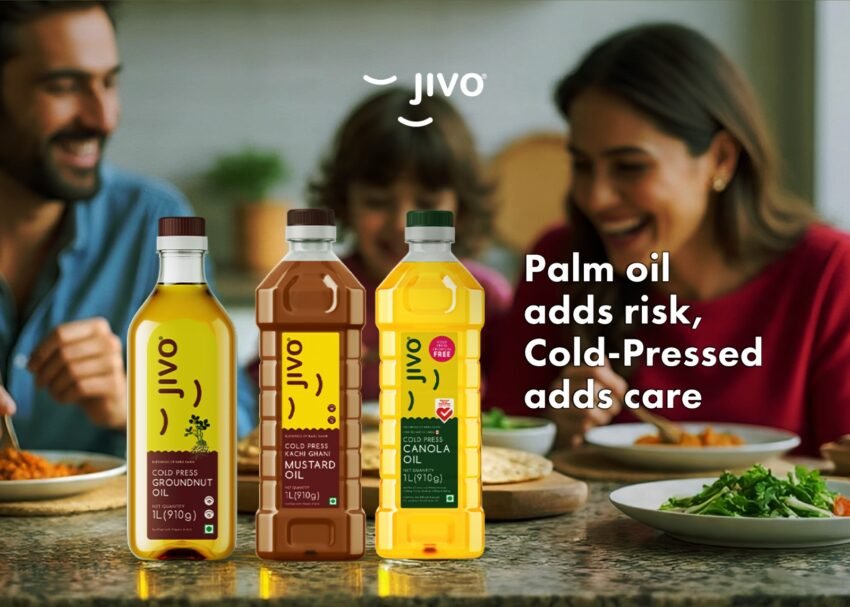Palm oil may not be the best cooking oils in India but you will be surprised to know that it is used in everyday products ranging from household items to industrial goods. It is used in food industry, personal care and cosmetics, biofuel and energy, animal feed and more.
In India, palm oil makes up about 38–40% of all edible oil consumption, making it a very important part of diets and industries. India imports most of its palm oil, which is popular because it is affordable and works well in cooking and many products.
However, palm oil does have health concerns because it contains saturated fats. Consuming it in large amounts may increase the risk of heart problems, so moderation is key.
What is Palm Oil?
Palm oil comes from the fruit of the oil palm tree, which grows mainly in tropical areas like Indonesia and Malaysia. These countries supply most of the world’s palm oil, and India relies heavily on imports to meet its needs. The oil is extracted from the fleshy part of the palm fruit, while a different type, palm kernel oil, comes from the seed inside.
One key thing about palm oil is its fat content. It has about 50% saturated fats, which are solid at room temperature and give it a stable texture. The rest includes monounsaturated fats (around 40%) and polyunsaturated fats (about 10%). Saturated fats are what make palm oil last longer on shelves without spoiling, but they can also affect health if overused.
Palm oil has a high smoke point, around 230°C (450°F), which means it doesn’t break down easily on heating. This makes this oil a great fit for frying and baking, as it resists heat and doesn’t break down producing harmful smoke or bad tastes at high temperatures. Compared to other types of cooking oils in India, like sunflower or soybean oil, palm oil’s smoke point is higher, reducing the chance of creating toxic compounds during cooking.
There are two main types of palm oil: refined and unrefined. The refined version of palm oil undergoes processing to remove colour, smell, and impurities. Unrefined palm oil, often called red palm oil, keeps its natural red colour from beta-carotene and has a stronger taste. This version retains more nutrients like vitamin E and antioxidants. In terms of nutrition, a tablespoon of palm oil has about 120 calories, mostly from fats, with small amounts of vitamins if it’s unrefined.
Overall, palm oil is versatile and cheap, but understanding its makeup helps decide if it’s right for your kitchen. When looking for healthy cooking oils in India, factors like fat types and processing matter a lot.
Where is Palm Oil Used?
Palm oil is a multi-utility oil and used in various preparations. In the food industry, it’s a staple for making snacks like biscuits, chips, and instant noodles. Its solid form at room temperature helps create that creamy texture in margarine, chocolate spreads, and ice cream. In India, palm oil is a popular oil in restaurants and street food stalls for deep-frying because of its stability (high smoke point) and low cost.
Apart from food, palm oil goes into personal care products. It is used in the preparation of soaps, shampoos, and lotions as it holds properties that acts as a base that moisturizes skin without feeling greasy. It is also used in cosmetics like lipstick and foundation because it smoothening effect. In biofuels, palm oil is turned into biodiesel, helping reduce reliance on fossil fuels, though this raises environmental questions.
Palm oil is used to feed animals and forms an important source of energy. Palm kernel cake (a by-product of palm oil extraction) is particularly valued as a high-energy, protein-rich feed ingredient for ruminants like cattle and goats.
Even in household cleaners and detergents, derivatives of palm oil help with foaming and cleaning power. Palm oil is also used in the preparation of industrial products like in paints, lubricants, and candles. With such wide use, palm oil supports economies but also sparks debates on sustainability. Palm oil indeed has a versatile use, but it might not always be the healthiest pick when it comes to human consumption.
What Makes Palm Oil Unhealthy?
Palm oil has a lot of saturated fat, which can raise bad cholesterol (LDL) in the blood. This might cause blocked arteries and heart problems over time. Eating too much saturated fat is linked to conditions like high blood pressure and strokes. In India, where heart disease is growing due to changing diets, using palm oil every day could add to this risk.
Another worry is how palm oil is processed. Refined palm oil loses healthy nutrients and might have harmful trans fats, though many brands avoid these now. Trans fats can cause inflammation and insulin problems, increasing the chance of diabetes. When palm oil is heated too much or used again, it can form harmful chemicals that may raise cancer risk.
Palm oil also has lots of calories, so eating too much can lead to weight gain. Some studies show it can cause fat to build up in the liver, which is unhealthy. But not all palm oil is bad — unrefined kinds have antioxidants that may help reduce some risks.
Used in small amounts, palm oil isn’t harmful. But eating too much, especially in processed foods, can be bad. When choosing cooking oils, check the labels for saturated fat to make healthier choices.
The Benefits of Palm Oil
Even with concerns, palm oil has some good points. Unrefined red palm oil has lots of vitamin E, which protects cells from damage as an antioxidant. It also contains beta-carotene, a type of vitamin A that helps eye health and the immune system. In places like parts of India, where vitamin shortages are common, this is helpful.
Palm oil is stable and doesn’t spoil quickly, so it lasts longer in kitchens. Its high smoke point means it stays safe during cooking without creating harmful substances, unlike oils with low smoke points. Some studies show the vitamin E forms in palm oil, called tocotrienols, might lower cholesterol and even fight cancer, but more research is needed.
Palm oil is affordable, making it a good option for low-income families. It’s also efficient to produce—palm trees give more oil per hectare than crops like sunflower or soy. For those wanting healthy cooking oils in India, palm oil can be part of a balanced diet if used in moderation with vegetables and whole grains.
Health Impacts: Weighing the Pros and Cons
Palm oil’s health effects depend on how much you eat and your overall diet. On the plus side, it has monounsaturated fats that can be good for your heart, similar to olive oil. If used in moderation and combined with exercise, it might not raise cholesterol too much.
But there are downsides. Palm oil is high in saturated fats, which can lead to obesity and health problems like diabetes, especially in India where diabetes is common. Health experts, including WHO, recommend keeping saturated fats under 10% of daily calories. Palm oil has about 50% saturated fat, so using a lot can make this hard to follow.
Everyone is different—age, genes, and lifestyle all matter. For most people, using small amounts of palm oil is okay, but relying on it too much isn’t wise. It’s best to ask a doctor or nutritionist for advice when choosing cooking oils in India.
Better Alternatives: Switching to Cold-Pressed Oils
If you are worried about palm oil’s drawbacks, try healthier options. Cold-pressed oils are made without heat or chemicals, keeping their nutrients and natural flavours. Most are FSSAI-approved, guaranteeing safety and quality. In India, cold-pressed oils are becoming more popular for their health benefits.
Oils like cold-pressed canola, mustard, and groundnut have less saturated fat and more heart-friendly nutrients. They work well for daily cooking, from stir-fries to salads, and fit perfectly into Indian dishes.
Jivo’s Cold-Pressed Canola Oil
Jivo’s Cold-Pressed Canola Oil is a light, heart-friendly oil rich in omega-3 fatty acids and antioxidants that help reduce inflammation. Its mild, neutral flavour makes it perfect for cooking, baking, sautéing, and frying without altering dish taste. Low in saturated fats, it supports healthy cholesterol levels and overall cardiovascular health, making it a smart choice for everyday Indian kitchens.
Jivo’s Cold-Pressed Mustard Oil
Known for its distinctive pungent flavour, Jivo’s cold-pressed mustard oil is rich in healthy monounsaturated fats and omega-3 fatty acids. It naturally contains antibacterial and antimicrobial compounds, helping preserve food and support digestive health. A traditional favourite in Indian kitchens, it’s ideal for pickles, curries, and everyday cooking. Thanks to its cold-pressed extraction, it retains antioxidants, vitamins, and anti-inflammatory properties, offering better stability and nutrition than refined oils.
Jivo’s Cold-Pressed Groundnut Oil
Jivo’s cold-pressed groundnut oil is rich in vitamin E and healthy fats, with a pleasant nutty aroma that enhances fried dishes. It supports heart health by helping balance cholesterol levels and is a great alternative to palm oil due to its lower saturated fat content. Perfect for Indian cooking, it adds both flavour and nutrition naturally.
Opting for these cold-pressed oils from brands like Jivo can be a simple step toward healthier habits. They’re part of the growing range of healthy cooking oils in India, easy to find and use.
Conclusion
Palm oil is affordable and versatile but has high saturated fat and health risks if used too much. Choosing healthier options like Jivo’s cold-pressed oils can be better. These oils keep natural nutrients, have less saturated fat, and are good for heart health. Eating a mix of oils and a balanced diet helps support overall well-being and fits different lifestyles.

